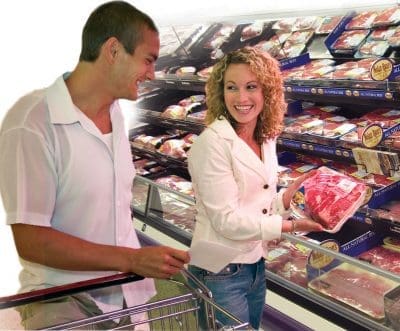DOMESTIC consumers are increasingly putting red meat in their trolley as retail prices push back against the inflation trend being seen more generally at the supermarket checkout.
Meat & Livestock Australia says it has analysed the relationship between prices seen for livestock at the saleyards, and prices of red meat at retail.
 Throughout this year, livestock prices for cattle and sheep have declined significantly, following historic highs in 2022. While livestock prices have decreased this year, MLA notes that the reduction in average retail price of red meat lags prices paid to producers by about eight months.
Throughout this year, livestock prices for cattle and sheep have declined significantly, following historic highs in 2022. While livestock prices have decreased this year, MLA notes that the reduction in average retail price of red meat lags prices paid to producers by about eight months.
While that statement may be true in the national supermarket channel, it certainly does not apply among independent butchers, as discussed in detail in this Beef Central article published last week. Butchers have been remarkably nimble in responding to price movements, passing large savings on to customers.
“This (eight month lag) is due to the amount of beef supply available, demand for Australian red meat in export markets, and rising input costs through the value chain,” MLA said in its statement issued today.
In the previous 12 weeks to 13 August, MLA said retail prices for beef and lamb declined significantly, following a trend that’s continued throughout 2023, demonstrating that the fall in livestock prices has started to impact the price paid at the checkout.
Retail prices and demand
“The performance of Australian beef and lamb in the domestic market remains solid, with both proteins growing in sales volume and overall value,” MLA said in its release.
When comparing the last quarter with the same period last year, value growth for beef was 1.8pc and for lamb, 4.2pc.
MLA’s general manager of marketing and insights, Nathan Low, said for beef, data from NielsenIQ HomeScan had reported 7.1pc growth in volume in the last quarter, compared to the same period last year, with an average retail price decrease of 4.9pc.
For lamb, NielsenIQ showed a 7.3pc reduction in the price consumers are paying compared to a year ago, which is supporting a 12.4pc increase in volume of lamb purchased at the cash register.
“Lamb had seen a boom in purchases in recent months, as consumers noticed its falling price and jumped on the opportunity to purchase a high quality and nutritious protein,” Mr Low said.
“The price reduction is translating to increased purchasing frequency for several cuts.”
That red meat trend was clearly documented in this Beef Central item published on Monday.
“This is especially the case for the most popular cuts like lamb legs and chops, which are up 20pc in volume compared to one year ago,” Mr Low said.
“Consumers see these price reductions and purchase more as a result. As this happens, retailers are looking to bring in customers with competitive pricing through catalogue promotions, and increased stock on the shelf,” he said.
Frequency of purchase and volume per purchase are both up in the latest quarter as well.
“Consumer perception of beef and lamb is strong,” Mr Low said.
“Tracking by Kantar, commissioned by MLA on behalf of industry, said that consumers see both beef and lamb as increasingly worth paying more for due to their high quality and taste.”
Relationship between livestock and retail meat prices
Historically, data on supply, pricing and consumer demand shows that it takes about eight months for livestock prices to translate to the retail shelf, MLA’s statement said.
The last time in recent history that beef prices dropped considerably was in 2012, with the lag to shelf arriving eight months later, with those lower prices remaining for about nine months.
For lamb, which has seen a drop in prices in the fourth quarter of the calendar year every year since 2018, it experienced significant price drops in 2012-13 and 2016-2018. Correspondingly, at this time, retail pricing took about nine months to fall.
Supply chain pressures
Mr Low said there were a variety of factors that drive pricing in the retail market, as well as additional supply chain pressures occurring currently.
“Livestock prices are only one component of retail meat prices,” he said.
“Producing retail meat requires investment in energy costs, transport and freight costs, labour costs, packaging and disposal costs, retailer margins, processor margins, PPE and hygiene, all of which have increased in price over the last year, along with almost everything else.”
“This is important to remember when considering when livestock prices increased as they did to historical highs last year. When saleyard prices were at those highs a year ago, retail prices increased, but not at the same rate.”
“What we are seeing now is that same trend, just in the opposite direction.”
“Consumers need a degree of certainty for their shopping basket and retailers smooth the retail pricing impact over the longer term, rather than sharply increase or decrease the price of meat in accordance with livestock prices.”



HAVE YOUR SAY